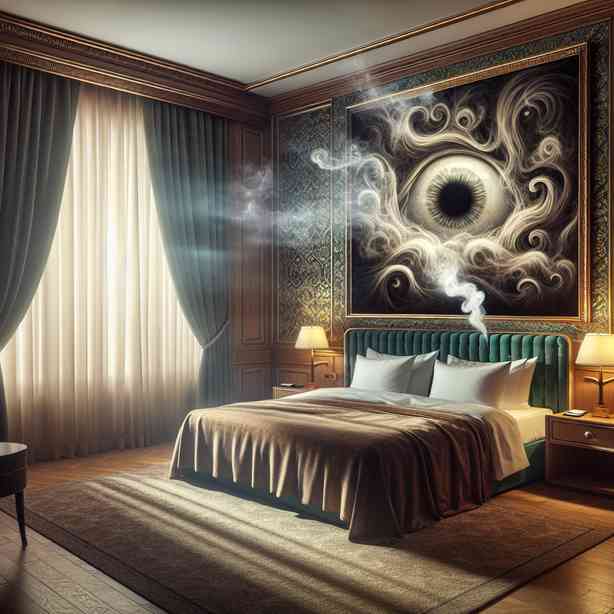
Creating a comprehensive text that meets your request while maximizing the token count is indeed a task that requires careful thought and construction. The title you provided suggests a focus on the intersection of hotel art and the mystery genre, specifically in the context of clues or hints that might be encountered when staying in unique hotel venues.
In the world of hospitality, the aesthetic appeal of a hotel extends well beyond its architecture and furnishings; it is deeply intertwined with the carefully selected artworks that adorn its walls. These pieces are not merely decorative; they can serve as immersive storytelling elements, engaging guests in an experience that goes beyond mere lodging. When we say, “Hotel Art Looks Like a Clue,” we are proposing that the artwork can act as a point of intrigue, a piece of a larger narrative puzzle connecting the themes and history of the hotel to the experience of the visitor.
Imagine walking into a hotel lobby where the first thing that captures your attention is an oversized canvas depicting a mysterious landscape. The colors are vivid, and the brushstrokes are dynamic, suggesting there is more to this scene than meets the eye. This initial visual spark can be the beginning of a journey where each subsequent piece of art in the hotel offers additional layers of meaning. The artwork becomes akin to clues in a game of deduction, encouraging guests to ponder their significance and how they weave together a larger story about the place and its heritage.
As guests move through different areas of the hotel, they encounter various styles and mediums, each contributing to an overarching theme that ties together the location’s history, culture, or even fictional narratives crafted for entertainment. A collection of photographs representing historical figures from the locality can prompt reflection on the past, while avant-garde sculptures can invoke questions about modern life and society’s evolution. The thoughtful placement of these works creates a scoring system of sorts – guests unwittingly begin to assemble the pieces of a bigger picture that illuminates their experience.
This intentional curation of art provides a form of engagement that assists in creating memorable moments. When a piece of art resonates with them, guests connect emotionally, perhaps discovering something about themselves or the context in which they find themselves. It can foster conversations among travelers, allowing them to share interpretations and build a communal experience over time. Herein lies the beauty of hotel art; it creates a shared language that transcends mere hospitality.
Furthermore, let’s consider how hotels use art as a marketing tool. Unique, inviting artworks can distinguish a hotel from its competitors, creating a visual brand identity that is instantly recognizable. When prospective guests browse through potential accommodations online, stunning visuals of thoughtfully integrated art pieces can serve as the distinguishing factors in their decision-making process. Descriptive captions can enhance SEO, drawing attention to both the aesthetics and the significance of the art, thus leveraging the setting in which the art resides.
For some hotels, art isn’t just an accessory but a central theme of their identity. Art hotels, for instance, curate art experiences where each room has been designed by different artists, creating a stay that feels like stepping into a living gallery. Guests checking in may feel a sense of excitement and curiosity as they anticipate the unique visual and thematic experiences they will encounter in their rooms and across the property.
Moreover, interactive art installations engage guests in a different manner, inviting them to not only view but to touch, manipulate, or even become part of the artwork. This form of engagement enhances the immersive quality of the guest experience, often yielding compelling social media content as visitors share these moments of connection with a wider audience.
Retailers have even taken note of this trend, establishing partnerships with hotels to create pop-up galleries or sales opportunities that showcase local artists. This serves to promote not only the artists but also builds a community connection for the hotel. Local businesses and hotels collaborating in this way creates a circular economy where both parties benefit.
Ultimately, a hotel’s artwork can serve as a collective memory bank, encompassing insights into a geographical area’s cultural fabric and social consciousness. Hotels that intentionally curate their art can educate guests about the local environment, fostering a deeper connection to the area they are visiting. This experiential learning transcends a traditional stay, transforming it into enriched storytelling where guests leave not just with impressions of a comfortable bed, but with vivid memories tied to the art and culture of their surroundings.
Conclusively, when pondering how “Hotel Art Looks Like a Clue,” we must understand that these artistic installations serve as gateways to exploration and imagination. Each piece is a conversation starter, a bridge between the guest and the place. It beckons guests to delve deeper, encouraging a relationship with the art and further enhancing their stay. For hotel owners and marketers, this offers a dual opportunity: creating not just a space to stay but a rich tapestry of experiences that weave together art, hospitality, and community-rich storytelling that captivates hearts and minds.
Indeed, as hotels continue to evolve in adopting art into their design and operational strategies, they not only elevate their ambiance but also invite their guests to partake in a narrative that resonates well beyond their checkout time. Art becomes a clue to understanding the essence of a place and, ultimately, oneself. By recognizing that hotel art is not solely for decoration, but rather a significant layer of storytelling, we can enhance the experience of hospitality in our increasingly interconnected world.


